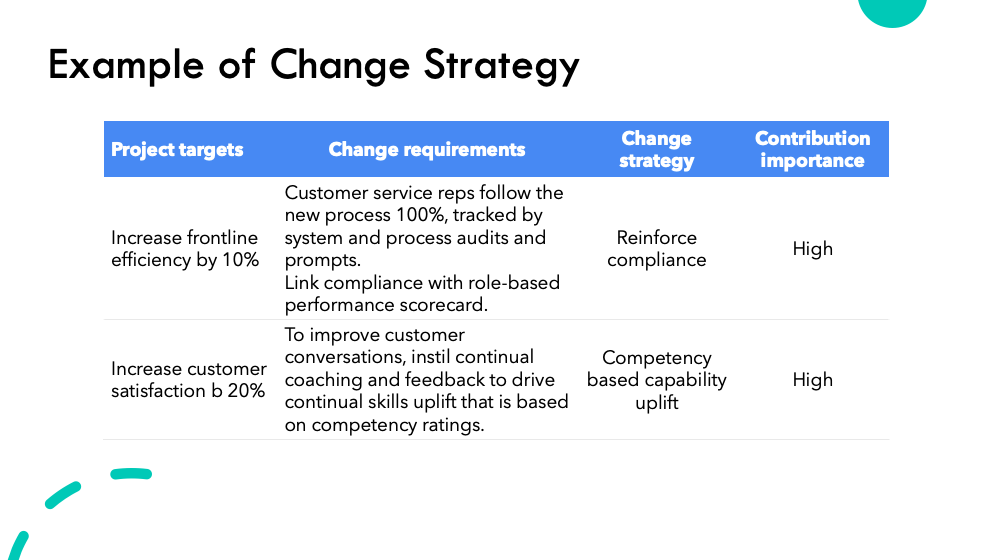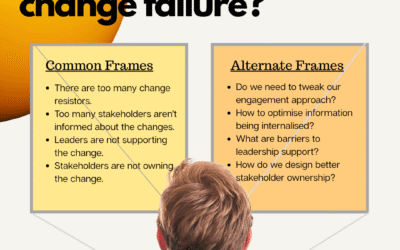Creating a change management strategy is one of the most important pieces of work for the change management practitioner. Done well, it can drive the change initiative to success. If not crafted carefully, it can lead the project to its downfall even before the project starts. A good change strategy should be logical, fact based and clear. Yet, despite its importance it is one of the least understood aspects of the change management process.
A key pitfall for the change practitioner in devising a change strategy is to create one that is ‘cookie cutter’ and ‘generic’. Creating a generic change strategy is very easy, not because the change practitioner is lazy or is incompetent, but mostly because there is usually a standard and acknowledged ‘way of doing things around here’ in organisations.
Organisations are used to doing things in certain ways and this is often incorporated as a part of the ‘culture’. ‘The way we do things around here’ is often the impetus by which stakeholders reinforce the ‘status quo’ of implementing change in a particular way. This is because ‘this way’ has always worked in the past and is what people are used to.
What’s wrong with using the status quo you may ask? Well, sometimes it may be the best way, but not always. Why? Because not all changes are the same.
Changes come in all shapes and sizes, some are large multi-year transformations whilst others are small process improvements. There are also different types of changes, ranging from significant organisational restructuring, system implementation through to new product launches. Some changes may require highly structured, process-centric implementation method such as a regulatory process change. Other changes may be better with a more agile approach, such as transformation programs to improve customer centricity.
Rather than asking what the stakeholders think would be the best change strategy or approach, take a fact-based approach. If possible, refer to previously implemented changes as benchmarks or comparison yard-sticks. Ask your stakeholders how previously implemented changes fared against their respective change management strategies.
Key points of your research should include the following:
- Size/Complexity of the change
- Context/Type of change
- Numbers of people impacted
- Length of the project
- Engagement and communication approaches taken
- Stakeholder education and influencing approaches taken
- Stakeholder responses and engagement levels
- Lessons learnt and what worked or did not work

Taking a benchmark approach to developing a change strategy ensures that you take into account the facts of what worked and did not work. You also take into account differences in the change initiatives and how these could have impacted the change strategy taken and therefore the corresponding outcomes. Where possible, use change metrics such as stakeholder responses or survey results. These are powerful indicators of change outcomes against the strategies taken.
Most change management strategies are not strategies
If you review change management strategies devised across initiatives, you will find that most change strategies are not actually strategies, but a compilation of change tactics. These change tactics are a list of aspirational ‘philosophies’ that may be nice to have but there is no real way of knowing how these drive the project to success.
Let’s look at some examples of these change tactics.
Be transparent and truthful. This is a common used one, where the goal is to be as authentic and truthful as possible with the goal of gaining trust of impacted stakeholders. This means not intending to making the messaging overly positive, and erring on the side of being as realistic as possible. This may be hard to implement if Corporative Affairs or Internal Communications does not agree with this approach.
Involve stakeholders in designing the change. This is another popular aspiration for change initiatives. The thinking is to be as inclusive as possible to include a range of stakeholders in the design and implementation of the change, so as to maximise engagement. The more engaged targeted stakeholders are the higher the changes of change adoption success.
Strong senior leader sponsorship. Thanks to a wide range of books and literature touting the importance of gaining senior leader sponsorship, this is another common one. Yes, having senior leaders driving the change will go a long way toward ensuring change outcome success. However, this in itself may not be sufficient. Again, depending on the type of change it maybe better to have a bottom-up, grass roots approach, rather than a top down approach.
All of the above change tactics may seem sound and logical. And they probably are. However, the whole point of a change strategy is not to list out a set of tactics, principles or philosophies. There could be a very long list of seemingly logical tactics. It also may not be possible or realistic to commit fully to every tactic.
Change strategy is about deciding what top few change approaches will be taken that will directly drive the most initiative success. This means that the change practitioner must start with the project targets and objectives. These should be as black and white indicators. For example, increase customer satisfaction by 10%, increase efficiency by 20%, or increase customer responses by 40%.
Now that you have identified the project targets and objectives from the project manager, you now need to identify change management requirements. For example, to increase efficiency by 10%, the project needs to ensure that the customer service representatives follow the new process 100% of the time. To do this, the project may need to design a series of audit and system notification processes to reinforce this behaviour. From a change management perspective your requirement could be ensuring that the report is built into and discussed by the relevant leaders and teams. Also, that the performance scorecard for concerned roles have built in these metrics.
Let’s take another example. To increase customer satisfaction by 20% the project needs to ensure that frontline agents know how to have the right type of conversations with customers. The change management requirement could be to instil continual coaching and feedback to drive continual skills uplift that is based on competency ratings. The Change strategy would then be driving competency based uplift.

In this way you can see that each part of the change strategy directly contributes to reaching the project targets. The direct contribution of each change strategy can then be evaluated in terms of its contribution importance.
So now you know how to devise a change strategy that directly contributes to the goals of the project. Your change management work should be geared around driving this strategy. And the contribution of your work should be clear and explicit. It should not be brushed aside as a ‘nice to have’ or too ‘soft and fluffy’.
If you want to learn more about creating the right change management metrics, visit The Ultimate Guide to Measuring Change.
Creating the right change management strategy is an important step. Even more important throughout the implementation of the project is how you monitor and adapt to the challenges that come your way. Change strategies may need to be tweaked or revised depending on the data you’re seeing along the way. To find out more about how to leverage data to resolve the most challenging questions during your change journey chat to us about how The Change Management platform can help.






